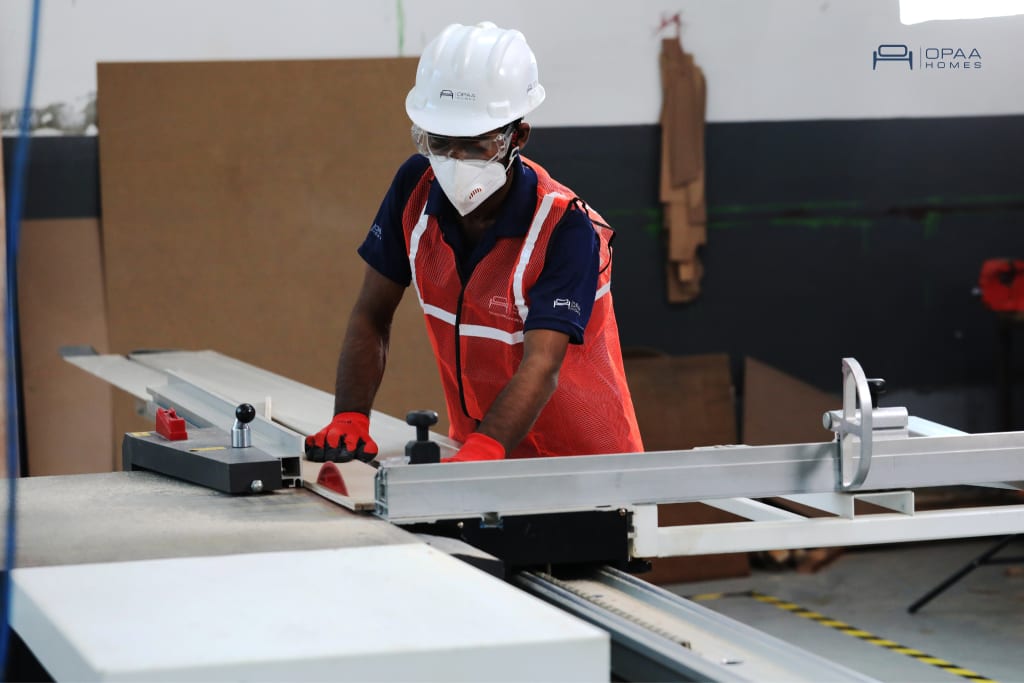Sustainable Living: Revolutionizing the Furniture Industry for a Better Tomorrow
As environmental awareness grows, the furniture industry is facing mounting pressure to address its ecological impact. Consumers are increasingly demanding eco-friendly options, driving a shift towards sustainability

Deforestation and Timber Sourcing
The furniture industry's heavy reliance on wood has profound implications for forests worldwide, leading to deforestation and significant biodiversity loss. This issue is particularly pressing as forests play a crucial role in carbon sequestration, climate regulation, and providing habitat for countless species. Unsustainable logging practices have led to the degradation of these vital ecosystems.
Solutions:
Certified Sustainable Wood: One of the primary solutions is the use of certified sustainable wood. Certification bodies like the Forest Stewardship Council (FSC) ensure that the wood is harvested in a way that maintains the forest's biodiversity, productivity, and ecological processes.
Reforestation Projects: Promoting and investing in reforestation projects can help restore degraded forests. These projects involve planting native trees, which support local ecosystems and communities.
Reclaimed Wood: Incorporating reclaimed wood into furniture design not only reduces the demand for new timber but also gives a second life to wood that might otherwise end up in landfills.
Chemical Use and Emissions
The production process in the furniture industry often involves harmful chemicals, including volatile organic compounds (VOCs) that contribute to indoor air pollution and pose health risks to both workers and consumers. Traditional finishes, adhesives, and treatments release these chemicals into the air, exacerbating environmental and health issues.
Solutions:
Low-VOC Finishes: Transitioning to low-VOC finishes can significantly reduce the emission of harmful chemicals. These finishes are designed to release fewer pollutants, improving indoor air quality.
Water-Based Adhesives: Unlike their solvent-based counterparts, water-based adhesives contain fewer harmful chemicals, making them a safer alternative for both the environment and human health.
Non-Toxic Dyes and Treatments: Using non-toxic dyes and treatments further minimizes the chemical footprint of furniture production. These alternatives are often derived from natural sources and are biodegradable.
Waste Management
Furniture production generates considerable waste, from offcuts and sawdust to discarded packaging materials. Moreover, when furniture reaches the end of its life, it often ends up in landfills, contributing to environmental degradation.
Solutions:
Zero-Waste Processes: Implementing zero-waste processes in manufacturing involves optimizing production to minimize waste. This can be achieved through careful planning, precision cutting, and reusing offcuts.
Recycling Materials: Recycling materials, such as metal and plastic components, reduces the need for virgin materials and helps divert waste from landfills.
Designing for Disassembly: Designing furniture for disassembly means creating products that can be easily taken apart, allowing individual components to be recycled or reused. This approach extends the product's lifecycle and promotes a circular economy.
Energy Consumption
Manufacturing furniture is energy-intensive, often relying on non-renewable sources that contribute to greenhouse gas emissions. Reducing energy consumption is essential for mitigating the industry's environmental impact.
Solutions:
Energy-Efficient Technologies: Investing in energy-efficient machinery and technologies can significantly reduce energy consumption. This includes using modern, efficient equipment that requires less power to operate.
Renewable Energy: Shifting to renewable energy sources, such as solar or wind power, can help lower the industry's carbon footprint. Many companies are now integrating solar panels into their facilities or purchasing renewable energy credits.
Sustainable Materials
The environmental footprint of non-renewable materials, like plastics and synthetic fabrics, is substantial. These materials are often derived from fossil fuels and are not biodegradable, contributing to pollution and resource depletion.
Solutions:
Natural, Renewable Materials: Using natural, renewable materials like bamboo, hemp, and organic cotton reduces reliance on non-renewable resources. These materials are often more sustainable and have a lower environmental impact.
Innovative Materials: Exploring innovative materials such as mushroom leather, recycled plastics, and bio-based composites can provide eco-friendly alternatives to traditional materials. These options often have the added benefit of being biodegradable or recyclable.
Supply Chain Transparency
A lack of transparency in the supply chain can mask unethical practices and environmental harm. Ensuring that every step of the supply chain adheres to ethical and sustainable standards is crucial.
Solutions:
Traceability of Materials: Implementing systems to trace the origin of materials ensures they are sourced responsibly. This can involve blockchain technology or certification schemes that track materials from source to final product.
Ethical Partnerships: Partnering with suppliers who adhere to sustainable practices and labor standards helps ensure that the entire supply chain supports environmental and social responsibility.
Third-Party Certifications: Obtaining third-party sustainability certifications provides an independent verification of a company's environmental and ethical practices. These certifications can cover aspects like fair labor, environmental impact, and product safety.
Circular Economy
The traditional linear economy of "take, make, dispose" leads to resource depletion and waste. A circular economy model, where products are designed for durability, repairability, and recyclability, offers a more sustainable approach.
Solutions:
Durability and Repairability: Designing furniture to be durable and easily repairable extends its lifespan, reducing the need for frequent replacements. This involves using high-quality materials and construction methods.
Furniture Rental and Take-Back Schemes: Business models such as furniture rental or take-back schemes encourage the reuse and recycling of products. Customers can return furniture at the end of its life for refurbishment or recycling, promoting a circular economy.
Consumer Awareness and Education
Consumers may not always be aware of the environmental impact of their furniture choices. Educating them about sustainable options and the benefits of eco-friendly furniture is essential for driving demand for sustainable products.
Solutions:
Clear Labeling: Providing clear labeling on products about their sustainability credentials helps consumers make informed choices. Labels can include information on materials, certifications, and environmental impact.
Educational Campaigns: Running educational campaigns through various channels can raise awareness about sustainability issues and the importance of eco-friendly furniture. This can involve blog posts, social media, workshops, and collaborations with influencers.
Promoting Benefits: Highlighting the benefits of sustainable furniture, such as improved indoor air quality, reduced environmental impact, and support for ethical practices, can encourage consumers to choose eco-friendly options.
Opaa Homes and Sustainability
At Opaa Homes, we prioritize sustainability by sourcing ethical materials, minimizing waste, creating timeless designs, and promoting recycling. Our commitment to environmental responsibility includes:
Ethically Sourced Materials: We prioritize sourcing wood from sustainable forests and use eco-friendly materials whenever possible.
Eco-Conscious Production: Our manufacturing processes are designed to minimize waste and reduce chemical use.
Innovative Designs: We focus on creating timeless, durable furniture that stands the test of time, reducing the need for frequent replacements.
Recycling and Upcycling: We incorporate recycled materials into our products and encourage our customers to participate in our take-back and recycling programs.
By addressing these concerns, the furniture industry can move towards a more sustainable future, benefiting both the environment and society. Together, we can lead the industry toward a greener future.
Explore luxury firsthand. Visit our website :-https://opaahomes.in/index.php
or Call Now :-9999727074 to discover the comfort and elegance of our expertly craft Sofas.
About the Creator
Enjoyed the story? Support the Creator.
Subscribe for free to receive all their stories in your feed. You could also pledge your support or give them a one-off tip, letting them know you appreciate their work.





Comments
There are no comments for this story
Be the first to respond and start the conversation.